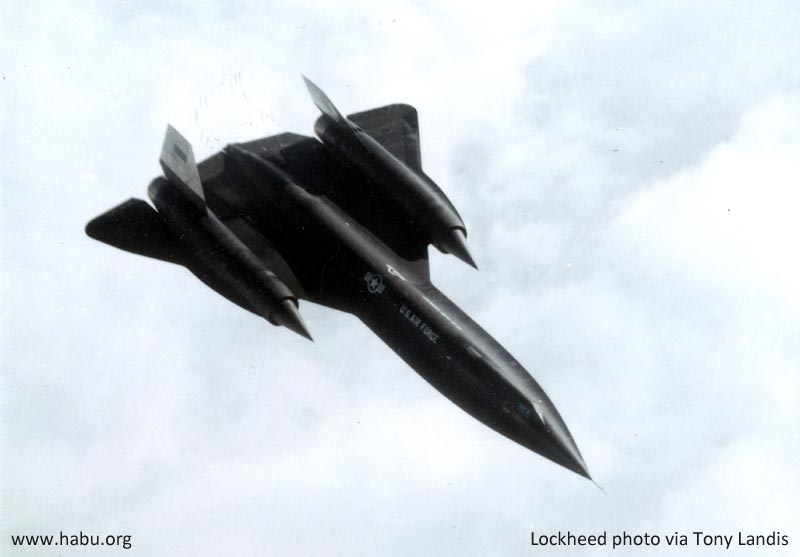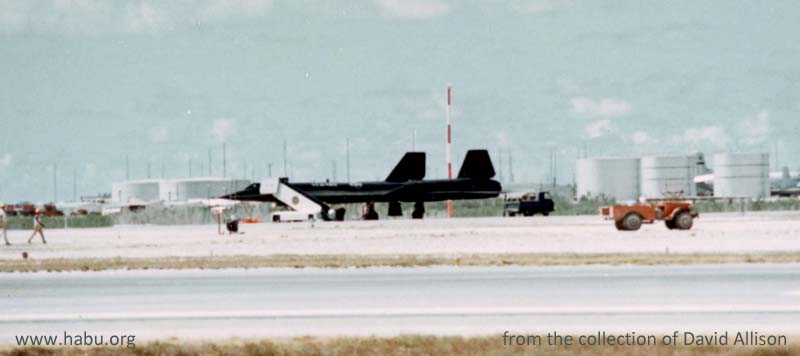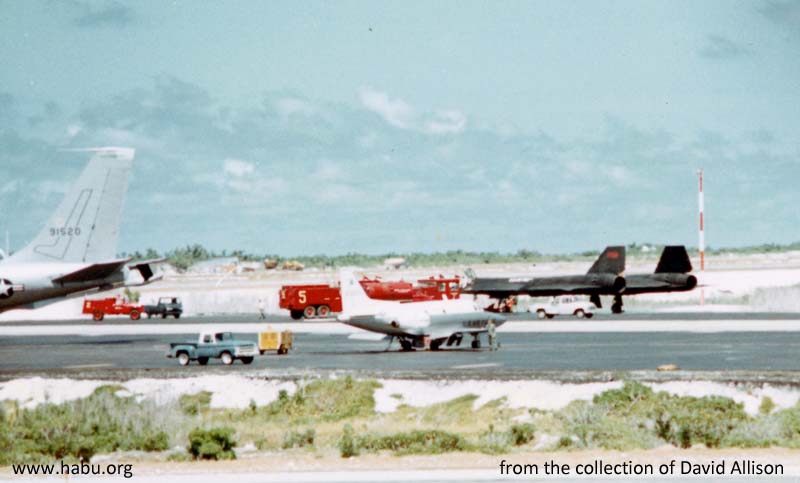|
60-6932

Photo courtesy Lockheed Martin

932 (also known as "Article 129") was one of three A-12s deployed operationally to Kadena AFB in Okinawa as part of Operation Black Shield. The other aircraft, Article 131 and Article 127, arrived on May 22 and May 24, 1967. Jack Weeks should have arrived with 932 on May 26, but his delivery of 932 was delayed a day due to an INS (Inertial Navigation System) problem. He had to divert to Wake Island, and arrived the next day on May 27.
These photos were taken on May 26, 1967 by an employee of Pan Am while the aircraft was diverted. KC-135Q #59-1520 was sent as the recovery aircraft.
 A mobile staircase courtesy of Pan Am allows pilot Jack Weeks egress from the plane. - Pan Am employee photo from the collection of David Allison
A mobile staircase courtesy of Pan Am allows pilot Jack Weeks egress from the plane. - Pan Am employee photo from the collection of David Allison
 Vehicles start surrounding the A-12 to block it from view; the A-12 wasn't supposed to exist in 1967, and the SR-71 was not yet operational. - Pan Am employee photo from the collection of David Allison
Vehicles start surrounding the A-12 to block it from view; the A-12 wasn't supposed to exist in 1967, and the SR-71 was not yet operational. - Pan Am employee photo from the collection of David Allison
 Pan Am helps out by parking a Boeing 707 in front of 932. - Pan Am employee photo from the collection of David Allison
Pan Am helps out by parking a Boeing 707 in front of 932. - Pan Am employee photo from the collection of David Allison
These photos of 932 are about the only thing left of her. She went down into the sea near the Phillipines on Wednesday, June 5, 1968 (NOTE: the official report says June 4, but most other sources say it was June 5), after exploding in flight at Mach 3 during a checkflight prior to returning her stateside. Although he didn't realize it at the time, Don Person (one of the first crew chiefs of the SR-71, and among the first group to be assigned to Det-1 at Kadena AFB), was one of the last people to seek Jack Weeks alive. He recalls:
Our KC-135Q tanker was inbound from Beale AFB on 5 June. Before
landing we were gathered together and notified that upon landing we
would see things we probably were not aware of and not to talk about
what we would see (otherwise on a "need to know basis"). The tanker
landed and spotted in a revetment. Once the large cargo door was
opened and steps were in place we departed to the flight ramp. As
soon as we were on the ground I heard the sound of J58 engines
coming down the taxiway. As 06932 passed the tanker I noticed this
was no ordinary SR-71: no RSO canopy, and red numbers [on one side, white tail numbers on the other]. Just
seeing the red numbers instead of the SR-71 white was enough to say
this was not a Beale SR-71. We
watched it taxi to the active runway and departed a short time later. I
can remember we all looked at each other in amazement but did not
discuss it as previously advised.
Rumors soon circulated that this aircraft was missing. SR-71 #974 (which
I was crew chief of) was generated for flight and flew the next day. Her
mission was to look for the missing aircraft. No such luck.
Months later, I found out about the A-12 aircraft and put two and two
together.
Not until several years ago did I see another A-12; landing at
San Diego you can see one in the Balboa Park. Also driving by the
battleship Alabama museum in Mobile Bay I also saw what I thought was
a SR-71 on display. Again not true, it also is an A-12. |
Because no trace of neither 932 nor her pilot, Jack Weeks, was ever found, some have speculated that Weeks "defected to the other side." These rumors are completely groundless, as Peter Merlin states in this August 1999 posting to the Skunkworks Mailing List: (reprinted by permission)
Date: Sun, 15 Aug 1999 02:28:37 EDT
From: Xelex@aol.com
Reply-To: skunk-works@netwrx1.com
To: skunk-works@netwrx1.com
Subject: Re: Birdwatcher and lost A-12
Here is some information on the Birdwatcher system and the loss of A-12 #129. Please excuse the length of this post (or rejoice in it).
The Birdwatcher constantly monitored various vital aircraft system functions,
as well as equipment functions. If and when established limits and equipment
activity were sensed, the Birdwatcher would key and modulate the HF
transmitter with a coded signal. The coded signal was a multiplexed sample of
each monitored item, including the item which triggered the Birdwatcher.
Thus, the intended receiver operator could determine which aircraft system
or equipment triggered the unit and could monitor the status of all remaining
items. There were 40 channels available, though not all were necessarily
used.
The system was controlled from the cockpit with a control panel shared with
the ECM and SIP controls on the righthand console. The Birdwatcher unit
utilized the HF transmitter, and was located in the lower right side of the
E-Bay, just behind the A-12 cockpit (C-Bay). Items monitored by Birdwatcher
included generator fail, transformer fail, altitude low, fuel quantity low,
destruct active, fuel flow low, hydraulic pressure low, System "A" and "B"
active, "A" and "B" hydraulic pressure low, oxygen pressure low, compressor
inlet temperature high, System "B" manual jam on, pitch and yaw acceleration,
cockpit pressure low, seat ejected, Code "A" and "B", angle of attack high,
fire warning, System "C" and "F" activity, oil pressure low, and EGT [Exhaust Gas Temperature] High Derich on.
If the Birdwatcher sensed a system limit or equipment activity, it would key
the HF tranmsitter and transmit three short, consecutive half-second bursts,
each separated by a five-second quiet period. During each burst, the
condition of all monitored items , as well as aircraft identity, was
transmitted. Upon transmission, the pilot heard three "chirps" in his
headset, and an activity light illuminated on the Birdwatcher control panel.
"Code A" and "Code B" switches on the panel could be used to retrigger the
Birdwatcher to indicate pilot awareness of Birdwatcher operation. By
prearrangement, activation of the "Code A" switch could indicate "pilot aware
- no emergency." In that case, "Code B" switch activation might indicate
"pilot aware - emergency condition."
Having transmitted, the Birdwatcher would not key the HF transmitter again
until another system limit was reached or another equipment activity was
sensed, or if the original triggering system returned within limits and
exceeded them again.
On 4 June 1968, Mr. Jack Weeks flew A-12 (#129) on a redeployment preparation
and functional check flight due to replacement of the right engine. Taxi and
takeoff were uneventful, as evidenced by the reception of the required
Birdwatcher "Code A" transmission and the lack of any HF transmissions from
the pilot. Refueling, 20 minutes after takeoff, was normal. At tanker
disconnect, the A-12 had been airborne 33 minutes. The tanker crew observed
the A-12 climbing on course in a normal manner. This was the last visual
sighting of the aircraft. No further communications were received until 19
minutes later when a Birdwatcher transmission indicated right engine EGT was
in excess of 860 degrees C. Seven seconds later, Birdwatcher indicated the
right engine fuel flow was less than 7500 pounds per hour and repeated that
EGT exceeded 860. Eight seconds later, Birdwatcher indicated that the A-12
was below 68,500 feet, and repeated the two previous warnings. This was the
final transmission.
Several attempts were made to contact Weeks via HF-SSB, UHF, and Birdwatcher,
but without success. Operation of recording and monitoring facilities at
the home base continued until the time that the aircraft's fuel would have
been exhausted, but no further transmissions were received. The aircraft was
declared missing some 500 nautical miles east of the Phillipines and 600
nautical miles south of Okinawa. The accident report declared that "No
wreckage of aircraft number 129 was ever recovered. It is presumed totally
destroyed at sea."
Peter W. Merlin
The X-HUNTERS
Aerospace Archeology Team
|
|



